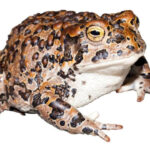- Discovering Arthroleptis nlonakoensis: The Hidden Jewel of Mount Nlonako's Forests
- Taxonomy and Classification of Arthroleptis nlonakoensis
- An Enchanting Yet Fragile Natural Habitat
- The Physical Beauty and Adaptations of Arthroleptis nlonakoensis
- Mysterious Lives Amid Leaf Litter: Behavior and Life Cycle
- A Vital Link Within its Ecosystem
- Facing Challenges: Threats and Conservation Insights
- Cultural and Scientific Significance of an Overlooked Amphibian
- A Call to Action: Protecting the Precious Nlonako Frog
Discovering Arthroleptis nlonakoensis: The Hidden Jewel of Mount Nlonako’s Forests#
In the lush, mist-covered forests of Mount Nlonako, nestled within Cameroon’s biodiverse landscape, lives an elusive frog known to science as Arthroleptis nlonakoensis. Silent guardian of its delicate ecosystem, this small amphibian goes unnoticed by most, yet possesses enormous ecological importance and extraordinary adaptations. Rising concern over deforestation and habitat fragmentation has brought scientists and conservationists alike together to unravel the mysteries of this remarkable creature, which is found nowhere else on Earth.
Curiously enough, despite its ecological significance and intriguing traits, this species remains relatively unknown beyond scientific circles. This amphibian is not merely another frog lost amid countless tropical species—it is, rather, a distinctive indicator of forest health and a mesmerizing native inhabitant with its own distinctive behaviors and life history.
Taxonomy and Classification of Arthroleptis nlonakoensis#
Arthroleptis nlonakoensis belongs to the family Arthroleptidae, commonly known as squeaker or litter frogs due to their characteristic calls or habitat preferences. Specifically, this genus, Arthroleptis, contains numerous ground-dwelling frog species notable for laying eggs terrestrially, bypassing aquatic tadpole stages.
This newly described species was first officially documented and named in 2019 by an international team of herpetologists whose research revealed subtle yet significant differences in morphology and genetic makeup from closely related species. Named after Mount Nlonako—the geographic cornerstone of its limited habitat—the species’ discovery highlighted once again the ever-evolving diversity hiding in Africa’s tropical rainforests.
Closely related species, such as Arthroleptis krokosua, which occupies forest regions in West Africa, share some characteristics with our Nlonako frog but demonstrate unique evolutionary paths shaped by geographical isolation and adaptation pressures.
An Enchanting Yet Fragile Natural Habitat#
The forests enveloping Mount Nlonako in southwestern Cameroon serve as the sole known refuge for Arthroleptis nlonakoensis. This species effortlessly embodies the essence of habitat specificity, relying heavily on pristine undergrowth and humid microclimates provided by the evergreen montane and sub-montane forests blanketing the terrain.
To wander beneath the towering trees of Mount Nlonako is to enter another world—an environment perpetually cloaked in mist, where light filters softly through dense foliage. These conditions yield a forest floor carpeted in thick leaf-litter. It is precisely this leaf-litter universe that provides habitat niches uniquely tailored to the lifecycles of Arthroleptid frogs.
The misty conditions and consistent humidity of the forest not only sustain the delicate skin of amphibians—which allows crucial respiration and hydration—but also sustain a thriving diversity of arthropods, paramount to the survival of insectivorous inhabitants like A. nlonakoensis.
The Physical Beauty and Adaptations of Arthroleptis nlonakoensis#
When observed closely, the subtleties and intricate details of Arthroleptis nlonakoensis become apparent. Typically small—measured adults rarely exceeding 25 millimeters in length—this species boasts intricate patterns of earthy brown shades, complemented by darker spots and irregular markings perfectly serving as camouflage against leaf-littered terrain.
The frog’s coloration and patterning illustrate an evolutionary triumph, allowing it to remain virtually invisible to keen-eyed predators. Large, expressive eyes positioned laterally grant superior peripheral vision, vital for detecting both prey and threats in the dim forest understory.
Moreover, the skin texture of A. nlonakoensis exhibits subtle granular patterns, aiding moisture retention and minimizing dehydration risks—a critical adaptation in its humid yet delicate rainforest ecosystem.
Mysterious Lives Amid Leaf Litter: Behavior and Life Cycle#
Life in these forests moves quietly, shaped by the rhythm of rainfall and humidity. Little known due to its secretive nature, Arthroleptis nlonakoensis exemplifies the hidden lives of leaf-litter frogs. Predominantly nocturnal, individuals move stealthily under the safety of darkness, hunting small arthropods, ants, spiders, mites, and various insects that inhabit leaf-litter.
A profound evolutionary hallmark sets this genus apart from traditional frogs: terrestrial egg-laying. Unlike many amphibians whose reproduction depends on freshwater bodies, female A. nlonakoensis deposit eggs carefully hidden among the forest floor’s organic debris. These eggs bypass the aqueous tadpole stage, developing directly into miniature froglets—a phenomenon known as direct development.
While the reproductive calls of these frogs might be less grandiose or melodious compared to their aquatic-dwelling cousins, they fulfill a crucial communicative function. During rainy seasons, male A. nlonakoensis vocalize from concealed forest litter or perches slightly above ground, emitting subtle patterns of squeaks and chirps designed to attract mates and defend territories.
A Vital Link Within its Ecosystem#
Despite its small size, the ecological role of Arthroleptis nlonakoensis in Mount Nlonako’s forests is pronounced. As agile predators of arthropods and small invertebrates, leaf-litter frogs maintain a crucial ecological balance—regulating insect populations and thus indirectly facilitating plant pollination and decomposition processes.
Equally important, as prey themselves, these frogs sustain predator diversity within food webs, nourishing a variety of birds, reptiles, and mammals. Additionally, amphibians worldwide are recognized as ecological indicators, their presence and well-being reflecting ecosystem health and stability. A healthy population of A. nlonakoensis inherently suggests thriving biodiversity and adequate environmental conditions for a range of species sharing its habitat.
Facing Challenges: Threats and Conservation Insights#
As fascinating as this species is, it sadly faces numerous conservation threats. Rapid deforestation poses the greatest risk, disrupting habitat connectivity, fragmenting viable forest floors, and compromising breeding and feeding grounds. Expansion of agriculture, logging activities, and human settlements significantly degrade or eliminate these vital domains, shrinking the already limited range of the species.
Moreover, global climate change, with shifting rainfall patterns and fluctuations in humidity levels, threatens to alter delicate moisture conditions crucial for amphibian survival. These frogs, hyper-sensitive to subtle environmental shifts, become vulnerable, warning us early of ecological imbalance.
Currently, due to its recent discovery and sparse scientific data, the International Union for Conservation of Nature (IUCN) lists A. nlonakoensis as “Data Deficient,” underscoring the importance of further surveys and monitoring to establish meaningful conservation plans effectively.
Cultural and Scientific Significance of an Overlooked Amphibian#
Knowledge and respect for local biodiversity have long infused indigenous traditions around Mount Nlonako. While specific cultural traditions about A. nlonakoensis are scant due largely to its inconspicuous nature, broader folkloric narratives of forest spirits and subtle beings demonstrate appreciation and reverence for biodiversity among local cultures.
Scientifically, frog species like Arthroleptis nlonakoensis represent keys to unlocking evolutionary mysteries of amphibians in fragmented environments. Studying the adaptations of such specialized organisms can provide critical insights into climate resiliency, ecosystem management practices, and biodiversity conservation strategies globally.
A Call to Action: Protecting the Precious Nlonako Frog#
The tale of Arthroleptis nlonakoensis is far from fully understood, but every hint uncovered is inspiring scientists, advocates, and enthusiasts to protect its fragile natural legacy. To safeguard the unique biodiversity richness of Mount Nlonako, urgent efforts involving habitat restoration, protected area development, community engagement, and further scientific research become imperative.
By reaffirming our commitment to conservation and nurturing appreciation for lesser-known species like Arthroleptis nlonakoensis, we invest in tomorrow’s ecological balance and biodiversity heritage. As stewards of nature, it is now upon us to learn, take action, and ensure the enduring survival of this hidden jewel within Cameroon’s treasured forests.










